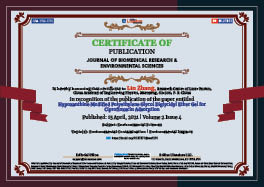Longfei Zhang, Shuai Zhang, Cheng Wang, Jiaming Hu, Wa Li, Shanggeng Li, Lirong Yang, and Lin Zhang*
Volume2-Issue4
Dates: Received: 2021-03-22 | Accepted: 2021-04-10 | Published: 2021-04-15
Pages: 244-250
Abstract
A hypoxanthine modified polyethylene glycol diglycidyl ether gel was prepared by the ring opening polymerization of polyethylene glycol diglycidyl ether with hypoxanthine in a simple sol-gel method. The structure and composition were characterized by SEM, FT-IR, BET and XRD. The adsorption experiments of ciprofloxacin at different pH, temperature, contact time and initial concentration were studied. The results show that the gel is porous with the average pore size of 5.2 nm, the optimum adsorption pH is 5 and the saturated adsorption time is 240 minutes. The maximum equilibrium adsorption capacity of ciprofloxacin is 56.1 mg/g at 308 K according to the Langmuir model. The repeated adsorption experiments show that the gel could still adsorb 80% of the first adsorbed ciprofloxacin after 5 times of elution. These results indicate that the gel can be used as a practical adsorbent for ciprofloxacin in aqueous solution.
FullText HTML
FullText PDF
DOI: 10.37871/jbres1219
Certificate of Publication

Copyright
© 2021 Longfei Zhang, et al. Distributed under Creative Commons CC-BY 4.0
How to cite this article
Zhang L, Zhang S, Wang C, Hu J, Li W, Li S, Yang L, Zhang L. Hypoxanthine Modified Polyethylene Glycol Diglycidyl Ether Gel for Ciprofloxacin Adsorption. J Biomed Res Environ Sci. 2021 Apr 15; 2(4): 244-250. doi: 10.37871/jbres1219, Article ID: jbres1219
Subject area(s)
References
- Picó Y, Andreu V. Fluoroquinolones in soil--risks and challenges. Anal Bioanal Chem. 2007 Feb;387(4):1287-99. doi: 10.1007/s00216-006-0843-1. Epub 2006 Nov 3. PMID: 17082879.
- Golet EM, Alder AC, Giger W. Environmental exposure and risk assessment of fluoroquinolone antibacterial agents in wastewater and river water of the Glatt Valley Watershed, Switzerland. Environ Sci Technol. 2002 Sep 1;36(17):3645-51. doi: 10.1021/es0256212. PMID: 12322733.
- Karthikeyan KG, Meyer MT. Occurrence of antibiotics in wastewater treatment facilities in Wisconsin, USA. Sci Total Environ. 2006 May 15;361(1-3):196-207. doi: 10.1016/j.scitotenv.2005.06.030. Epub 2005 Aug 8. PMID: 16091289.
- Kolpin DW, Furlong ET, Meyer MT, Thurman EM, Zaugg SD, Barber LB, Buxton HT. Pharmaceuticals, hormones, and other organic wastewater contaminants in U.S. streams, 1999-2000: a national reconnaissance. Environ Sci Technol. 2002 Mar 15;36(6):1202-11. doi: 10.1021/es011055j. PMID: 11944670.
- Miao XS, Bishay F, Chen M, Metcalfe CD. Occurrence of antimicrobials in the final effluents of wastewater treatment plants in Canada. Environ Sci Technol. 2004 Jul 1;38(13):3533-41. doi: 10.1021/es030653q. PMID: 15296302.
- Renew JE, Huang CH. Simultaneous determination of fluoroquinolone, sulfonamide, and trimethoprim antibiotics in wastewater using tandem solid phase extraction and liquid chromatography-electrospray mass spectrometry. J Chromatogr A. 2004 Jul 9;1042(1-2):113-21. doi: 10.1016/j.chroma.2004.05.056. PMID: 15296395.
- Genc N, Dogan E C. Adsorption kinetics of the antibiotic ciprofloxacin on bentonite, activated carbon, zeolite, and pumice. Desalin Water Treat. 2015;53(3):785-793. https://bit.ly/2QztHff
- Ahmadzadeh S, Asadipour A, Pournamdari M, Behnam B, Rahimi H R, Dolatabadi M. Removal of ciprofloxacin from hospital wastewater using electrocoagulation technique by aluminum electrode: optimization and modelling through response surface methodology. Process Saf Environ Prot. 2017;109:538-547. https://bit.ly/3lX7ovF
- Sun SP, Guo HQ, Ke Q, Sun JH, Shi SH, Zhang ML, et al. Degradation of antibiotic ciprofloxacin hydrochloride by photo-Fenton oxidation process. Environ Eng Sci. 2009;26(4):753-759. https://bit.ly/3lRKg1r
- De Witte B, Van Langenhove H, Demeestere K, Saerens K, De Wispelaere P, Dewulf J. Ciprofloxacin ozonation in hospital wastewater treatment plant effluent: effect of pH and H2O2. Chemosphere. 2010 Feb;78(9):1142-7. doi: 10.1016/j.chemosphere.2009.12.026. Epub 2010 Jan 13. PMID: 20074775.
- Sun SP, Hatton TA, Chung TS. Hyperbranched polyethyleneimine induced cross-linking of polyamide-imide nanofiltration hollow fiber membranes for effective removal of ciprofloxacin. Environ Sci Technol. 2011 May 1;45(9):4003-9. doi: 10.1021/es200345q. Epub 2011 Apr 1. PMID: 21456576.
- Babel S, Kurniawan TA. Low-cost adsorbents for heavy metals uptake from contaminated water: a review. J Hazard Mater. 2003 Feb 28;97(1-3):219-43. doi: 10.1016/s0304-3894(02)00263-7. PMID: 12573840.
- Ademoriyo CO, Enyoh CE. Batch Adsorption Studies of Sunset Yellow and Tartrazine Using Coconut and Groundnut Shells. J Biomed Res Environ Sci. 2020;1(5):163-172. https://bit.ly/3lRoZoP
- Gupta VK, Suhas. Application of low-cost adsorbents for dye removal--a review. J Environ Manage. 2009 Jun;90(8):2313-42. doi: 10.1016/j.jenvman.2008.11.017. Epub 2009 Mar 4. PMID: 19264388.
- Kono H, Nakamura T, Hashimoto H, Shimizu Y. Characterization, molecular dynamics, and encapsulation ability of β-cyclodextrin polymers crosslinked by polyethylene glycol. Carbohydr Polym. 2015 Sep 5;128:11-23. doi: 10.1016/j.carbpol.2015.04.009. Epub 2015 Apr 18. PMID: 26005135.
- Jawada AH, Mamata NFH, Hameedb BH, Ismail K. Biofilm of cross-linked Chitosan-Ethylene Glycol Diglycidyl Ether for removal of Reactive Red 120 and Methyl Orange: Adsorption and mechanism studies. J Environ Chem Eng. 2019;7:102965. https://bit.ly/2P5peAG
- He Q, Kusumi R, Kimura S, Kim UJ, Deguchi K, Ohki S, Goto A, Shimizu T, Wada M. Highly swellable hydrogel of regioselectively aminated (1→3)-α-d-glucan crosslinked with ethylene glycol diglycidyl ether. Carbohydr Polym. 2020 Jun 1;237:116189. doi: 10.1016/j.carbpol.2020.116189. Epub 2020 Mar 16. PMID: 32241412.
- Dai Z, Ansaloni L, Gin DL, Noble RD, Deng L. Facile fabrication of CO2 separation membranes by cross-linking of poly(ethylene glycol) diglycidyl ether with a diamine and a polyamine-based ionic liquid. J Membrane Sci. 2017;523:551-560. https://bit.ly/3fi6wQX